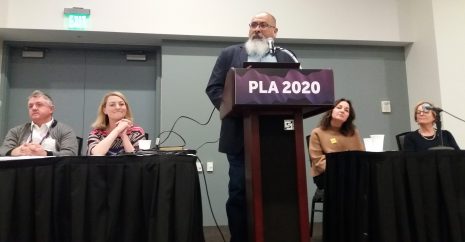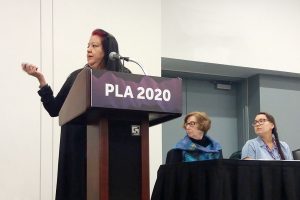
In the past, it was all about what the architect thought would be cool,” said Danielle Milam, director of development and planning for Las Vegas-Clark County Library District. But now, she said, library design is shifting from the architect-led to the human-centered and community-focused.
“Architecture isn’t about buildings, it’s about people,” said Jeffery Davis, library planner and designer at Architectural Nexus in Salt Lake City. Davis, Milam, and fellow panelists at “Inclusionary Tactics that Flip the Script for Library Facility Planning,” a February 28 program of the Public Library Association 2020 Conference in Nashville, emphasized that library design’s new direction is embracing inclusion, strategic plans, and specific neighborhood needs.
“[In the past, architects were] often asking about linear shelving. I didn’t want that to be the thing that led community design,” said Melanie Huggins, executive director of Richland Library in Columbia, South Carolina, whose own system allocated $66 million for construction and renovation on all facilities. “How do we want the space to feel? What do we want people to achieve in this space?”
In envisioning and planning new spaces, Huggins and her teams consulted many resources—the library’s strategic plan, United Nations Sustainable Development Goals, the Knight Foundation’s Soul of the Community study—as well as solicited feedback from local stakeholders.
“We talked to 30 leaders and got some real in-depth feedback for our plan and goals,” she said. “‘Tell us the top three things of concern to you as chief of police. Tell us the top three things of concern to you as superintendent of schools.’”
Based on brainstorming and responses, Richland Library began to think of branch libraries as “independent community engagement engines,” with different focuses. For example, the North Main branch, in a predominantly African-American neighborhood, would emphasize teen engagement and business development. “We knew when we redesigned and renovated, we needed it to be a vibrant community center,” said Huggins. The Northeast branch, in a neighborhood where many languages are spoken, showcases a children’s room and teaching kitchen, designed to bring people of all culinary backgrounds together.
Margaret Sullivan of design firm Margaret Sullivan Studio in New York City proclaimed this type of thinking the next era of social impact design. “[We’re] activating every square foot of public library space for the public good,” she said. “Who is ready to lead with your unwavering values of community and inclusion?”
Inclusion underscores the transformation of the East Las Vegas (Nev.) Library (ELVL), a 41,000-square-foot construction that cost $26 million and opened in 2019.
“It’s owned by the community,” said Salvador Avila, branch manager. “I know all of these folks on a first-name basis. [They] grew up on the same property where the library stands.”
Avila said opening the library, now one of the busiest in the state, was just the first step. The goal of the new space and its amenities—which include a sound booth, green screen, podcast room, study rooms, DJ-ing equipment, and multigenerational living room—was giving the majority-Latinx population “reasons to succeed.”
“The library thrives on a culture of creation rather than consumption,” Avila said. “It serves as a hub, it’s all digital.” He joked, “Not one Post-It will be found in this building.”
Avila’s advice for those planning facilities? Take risks. For example, ELVL has extended hours to accommodate certain programs, and it invited the governor to sign two bills into law in the library space—one of which prohibited denying professional licensing based on immigration status—as a way to build trust in the community and get people to see the library supports them.
“Do not play it safe,” Avila said.
Ed. note: Salvador Avila is a current member of the American Libraries Advisory Committee.

